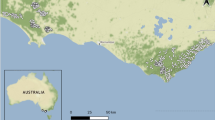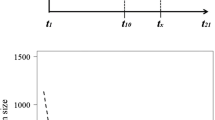Abstract
Control of invasive predators is necessary for the conservation of many endemic species. Invasive predator management tends to focus on priority sites, which often comprise only a small fraction of the impacted area. Landscape-scale ecological recovery requires threatening processes to be managed not only in these priority areas, but also in the matrix between them. However, wide-scale control of invasive species can be logistically, economically and socially challenging. We developed a spatially explicit model to estimate the effects of varying levels of landholder participation in landscape-scale programs to control invasive predators. We demonstrate the use of this model with a case study from the North Island of New Zealand in which the results of predator control are projected over a 6 year period. Under various scenarios for landholder participation, we estimated how the participation rate, and size and location of non-participating properties, would influence effectiveness of predator trapping. We also modelled how trap deployment could be adjusted to limit reinvasion from non-participating properties. Under all modelled scenarios, predator populations remained below pre-control levels throughout the 6 years. Non-participation by owners of small properties (≤25 ha) had a negligible effect on the efficacy of predator control. If owners of large properties (>800 ha) failed to participate, reinvasion by predators from these properties reduced the efficacy of control; however, this could be largely offset by placing additional traps on the nearest participating properties. Predator control will thus be effective even if some landholders choose not to participate. Our model can be readily adapted to other invasive species and landscapes worldwide.


Similar content being viewed by others
References
Alterio N (1996) Secondary poisoning of stoats (Mustela erminea), feral ferrets (Mustela furo), and feral house cats (Felis catus) by the anticoagulant poison, brodifacoum. N Z J Zool 23:331–338
Aslan CE, Hufford MB, Epanchin-Niell RS, Port JD, Sexton JP, Waring TM (2009) Practical challenges in private stewardship of rangeland ecosystems: yellow starthistle control in Sierra Nevadan foothills. Rangel Ecol Manag 62:28–37
Bandura A (1998) Personal and collective efficacy in human adaptation and change. Adv Psychol Sci 1:51–71
Barlow ND, Barron MC (2005) Modelling the dynamics and control of stoats in New Zealand forests. Sci Conserv 252:1–39
Barlow ND, Norbury GL (2001) A simple model for ferret population dynamics and control in semi-arid New Zealand habitats. Wildl Res 28:87–94
Byrom AE (2002) Dispersal and survival of juvenile ferrets Mustela furo in New Zealand. J Appl Ecol 39:67–78
Cialdini EB, Reno RR, Kallgren CA (1990) A focus theory of normative conduct: recycling the concept of norms to reduce littering in public places. J Personal Soc Pyschol 58:1015–1026
Clapperton BK, Byrom AE (2005) Feral ferret Mustela furo Linnaeus, 1758. In: King CM (ed) The handbook of New Zealand mammals, 2nd edn. Oxford University Press, Melbourne, pp 294–307
Clayton R, Cowan P (2010) Management of animal and plant pests in New Zealand: patterns of control and monitoring by regional agencies. Wildl Res 37:360–371
Corbett JB (2002) Motivations to participate in riparian improvement programs: applying the theory of planned behavior. Sci Commun 23:243–263
Cumming GS, Olsson P, Chapin F, Holling C (2013) Resilience, experimentation, and scale mismatches in social-ecological landscapes. Landscape Ecol 28:1139–1150
Derenne P (1976) Notes sur la biologie du chat haret de Kerguelen. Mammalia 40:531–595
Dickman CR (1996) Impact of exotic generalist predators on the native fauna of Australia. Wildl Biol 2:185–195
Efford M (2004) Density estimation in live-trapping studies. Oikos 106:598–610
Epanchin-Niell RS, Hufford MB, Aslan CE, Sexton JP, Port JD, Waring TM (2009) Controlling invasive species in complex social landscapes. Front Ecol Environ 8:210–216
Fowler JH, Christakis NA (2010) Cooperative behavior cascades in human social networks. Proc Natl Acad Sci USA 107:5334–5338
Gentle MN, Saunders GR, Dickman CR (2007) Poisoning for production: How effective is fox baiting in south-eastern Australia? Mammal Rev 37:177–190
Gillies CA, Fitzgerald BM (2005) Feral cat, Felis catus Linnaeus, 1758. In: King CM (ed) The handbook of New Zealand mammals, 2nd edn. Oxford University Press, Melbourne, pp 308–326
Glen AS, Byrom AE (2014) Implications of landholder buy-in for the success of regional-scale predator control. Part 1: review of predator movements. Contract Report LC1956 for Hawke’s Bay Regional Council. Landcare Research, Lincoln
Glen AS, Pech RP, Byrom AE (2013) Connectivity and invasive species management: towards an integrated landscape approach. Biol Invasions 15:2127–2138
Herrerias PR, Garcia PJ, Cruz RS (2003) A note on the reasonableness of PERT hypotheses. Oper Res Lett 31:60–62
Innes J, Kelly D, Overton JM, Gillies C (2010) Predation and other factors currently limiting New Zealand forest birds. N Z J Ecol 34:86–114
Innes J, Burns B, Sanders A, Hayward MW (2015) The impact of private sanctuary networks on reintroduction programs. In: Armstrong D, Hayward M, Moro D, Seddon P (eds) Advances in reintroduction biology of Australian and New Zealand Fauna. CSIRO Publishing, Collingwood, pp 185–200
Jackson T (2005) Motivating sustainable consumption: a review of evidence on consumer behavior and behavioral change. Sustainable Development Rersearch Network, London
Karali E, Brunner B, Doherty R, Hersperger A, Rounsevell M (2014) Identifying the factors that influence farmer participation in environmental management practices in Switzerland. Hum Ecol 42:951–963
Kendal JR, Laland KN (2000) Mathematical models for memetics. J Memet 4. http://cfpm.org/jom-emit/2000/vol4/kendal_jr&laland_kn.html
King CM (1983) Mustela erminea. Mammalian Species 195:1–8
King CM, Murphy EC (2005) Stoat Mustela erminea Linnaeus, 1758. In: King CM (ed) The handbook of New Zealand mammals, 2nd edn. Oxford University Press, Melbourne, pp 261–287
Kinnear JE, Onus ML, Bromilow RN (1988) Fox control and rock-wallaby population dynamics. Aust Wildl Res 15:435–450
Korpimäki E, Norrdahl K, Rinta-Jaskari T (1991) Responses of stoats and least weasels to fluctuating food abundances: Is the low phase of the vole cycle due to mustelid predation? Oecologia 88:552–561
Lade SJ, Tavoni A, Levin SA, Schlüter M (2013) Regime shifts in a social-ecological system. Theor Ecol 6:359–372
MacLeod LJ, Hine DW, Please PM, Driver AB (2015) Applying behavioral theories to invasive animal management: towards an integrated framework. J Environ Manage 161:63–71
Montanari A, Saberi A (2010) The spread of innovations in social networks. Proc Natl Acad Sci USA 107:20196–20201
Murphy EC, Dowding JE (1994) Range and diet of stoats (Mustela erminea) in a New Zealand beech forest. N Z J Ecol 18:11–18
Norbury G, Byrom AE, Pech R, Smith J, Clarke D, Anderson DP, Forrester G (2013) Invasive mammals and habitat modification interact to generate unforeseen outcomes for indigenous fauna. Ecol Appl 23:1707–1721
Norbury GL, Pech RP, Byrom AE, Innes J (2015) Density-impact functions for terrestrial vertebrate pests and indigenous biota: guidelines for conservation managers. Biol Conserv 191:409–420
Prinbeck G, Lach D, Chan S (2011) Exploring stakeholders’ attitudes and beliefs regarding behaviors that prevent the spread of invasive species. Environ Educ Res 17:341–352
Rebaudo F, Dangles O (2013) An agent-based modeling framework for integrated pest management dissemination programs. Environ Model Softw 45:141–149
Russell JC, Innes JG, Brown PH, Byrom AE (2015) Predator-free New Zealand: conservation country. BioScience 65:520–525
Salo P, Korpimäki E, Banks PB, Nordström M, Dickman CR (2007) Alien predators are more dangerous than native predators to prey populations. Proc R Soc Lond Ser B Biol Sci 274:1237–1243
Sanson R, Cook A, Fairweather J (2004) A study of smallholdings and their owners. MAF Information Paper No. 53. Ministry of Agriculture & Forestry, Wellington
Short J, Turner B (2005) Control of feral cats for nature conservation. IV. Population dynamics and morphological attributes of feral cats at Shark Bay, Western Australia. Wildl Res 32:489–501
Simberloff D (2010) Invasive species in New Zealand. In: Sodhi NS, Ehrlich PR (eds) Conservation biology for all. Oxford University Press, Oxford, pp 132–133
Sinclair ARE (1996) Mammal populations: fluctuation, regulation, life history theory and their implications for conservation. In: Floyd RB, Sheppard AW, De Barro PJ (eds) Frontiers of population ecology. CSIRO Pubslishing, Collingwood, pp 127–154
Thompson SD (1987) Body size, duration of parental care, and the intrinsic rate of natural increase in eutherian and metatherian mammals. Oecologia 71:201–209
van Aarde RJ (1984) Population biology and the control of feral cats on Marion Island. Acta Zool Fenn 172:107–110
Ward-Smith T (2011) Translocations to Cape Sanctuary: What has been learnt? Notornis 58:180
Acknowledgments
Funding was provided by Hawke’s Bay Regional Council and the New Zealand Ministry of Business, Innovation & Employment. We thank M. Barron, P. Cowan and two anonymous referees for helpful comments on an earlier draft.
Author information
Authors and Affiliations
Corresponding author
Electronic supplementary material
Below is the link to the electronic supplementary material.
Rights and permissions
About this article
Cite this article
Glen, A.S., Latham, M.C., Anderson, D. et al. Landholder participation in regional-scale control of invasive predators: an adaptable landscape model. Biol Invasions 19, 329–338 (2017). https://doi.org/10.1007/s10530-016-1282-3
Received:
Accepted:
Published:
Issue Date:
DOI: https://doi.org/10.1007/s10530-016-1282-3




